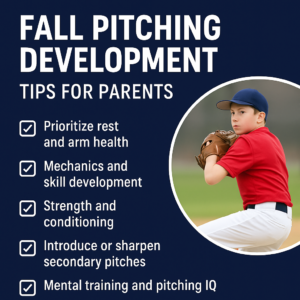Fall Pitching Development: A Parent’s Guide to Helping Young Athletes Improve on the Mound
 For many baseball families, fall marks the transition from a busy summer of games to a more developmental-focused season. While it can be tempting to keep playing year-round, the fall is actually one of the best times for young pitchers to build skills, improve mechanics, and protect their arms for the long term.
For many baseball families, fall marks the transition from a busy summer of games to a more developmental-focused season. While it can be tempting to keep playing year-round, the fall is actually one of the best times for young pitchers to build skills, improve mechanics, and protect their arms for the long term.
If your child is serious about pitching, here’s a recommended training approach to follow this fall.
1. Prioritize Rest and Arm Health
After a long spring and summer of innings, the first step in fall should be recovery. Overuse is the number one cause of arm injuries in youth pitchers.
-
Rest from live games: Take 4–6 weeks off from competitive pitching.
-
Keep the arm moving: Light throwing and long toss can stay in the mix, but without the stress of high pitch counts.
-
Focus on flexibility: Shoulder and hip mobility are key for a healthy delivery.
2. Mechanics and Skill Development
The fall is the perfect time to clean up mechanics without game pressure.
-
Work with a coach or trainer to identify inconsistencies in delivery.
-
Drill the basics: balance point, stride direction, glove side stability, and follow-through.
-
Video analysis can be especially helpful for younger athletes to see and correct their movements.
3. Strength and Conditioning
Pitching isn’t just about the arm — it’s about using the whole body.
-
Core strength: Planks, med-ball throws, and rotational exercises.
-
Lower body: Squats, lunges, single-leg stability drills.
-
Arm care: Bands, lightweight shoulder exercises, and wrist/forearm strengthening.
-
Avoid heavy weights for very young athletes; bodyweight and light resistance are best.
4. Introduce or Sharpen Secondary Pitches (Age-Appropriate)
-
Youth pitchers (ages 9–12): Master the fastball and changeup before adding more pitches.
-
Teen pitchers (ages 13+): Begin refining a breaking ball with proper guidance to avoid stress on the elbow.
-
Consistency first: It’s better to have two reliable pitches than four inconsistent ones.
5. Mental Training and Pitching IQ
Pitching is as much mental as it is physical.
-
Learn pitch sequences — when to throw what.
-
Study the game: Watch older pitchers or MLB games and discuss pitch selection.
-
Build confidence: Celebrate progress in practice, not just results in games.
6. A Sample Fall Pitching Program
Here’s how a weekly schedule could look for a young pitcher in the fall:
-
2–3 days/week: Light throwing + pitching mechanics drills (20–30 minutes)
-
2 days/week: Strength and conditioning (core + lower body + arm care)
-
1 day/week: Recovery session (mobility, stretching, foam rolling, light cardio)
-
Daily: 10–15 minutes of arm care and mobility work
This balanced approach ensures pitchers improve without risking overuse.
Why This Matters
Too many young athletes treat pitching as a year-round grind, which often leads to burnout or injury. By taking a thoughtful fall approach — focusing on mechanics, strength, recovery, and pitching IQ — your child can build a stronger foundation and be ready to dominate when the spring season rolls around.
At R3 Athlete Performance, we combine this developmental approach with recovery programs and skill-specific pitching lessons designed to help young athletes stay healthy and thrive.
👉 Parents: Give your young pitcher the best chance to succeed. Fall isn’t about throwing more innings — it’s about building the foundation for long-term success on the mound.

